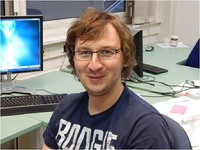Reciprocal and Real Space Investigation of Ag/Pt(111) Growth, Structure and Interaction with Oxygen
Promotion date: September 26.
Promotor: Prof. dr. Bene Poelsema
Assistant Promotor: Dr. ir. Herbert Wormeester
| This thesis described the growth and structure of the Ag/Pt(111) surface alloy and its interaction with oxygen. The alloy was investigated using spot profile analyses low energy electron diffraction (SPA-LEE), low energy electron microscopy (LEEM), and thermal desorption spectroscopy (TDS). This combination allows a detailed characterization of the structure and morphology, at sub-monolayer and higher coverage of Ag. Complex processes of alloying, dealloying, surface phase transitions, segregation, and the formation of a dislocation network at the buried interface are observed, as well as the affinity to the dissociative absorption of oxygen, a vital step in catalytic oxidation reactions. |
What were the main stages of your PhD research?
We have studied AgPt surface confine alloy formed by deposition of thin Ag layers, varying from 0-7 nm, on Pt(111) crystal in ultra-high vacuum conditions. The alloying of the surface is induced by thermal heating of the surface. Mixing of the material is limited only to the few atomic layers at Ag-Pt(111) interface. At sub-monolayer coverage the alloy has a structure of well separated 1.5 nm wide Ag- and Pt- rich patches.
Deposition of two monolayer thick Ag film leads to formation of complex trigonal dislocation networks at the Ag-Pt(111) interface, which causes that thicker Ag films deposited on top of dislocation network are periodically undulated. Later we studied the adsorption of oxygen on this alloyed surface and influence of the oxygen on the surface morphology. We used surface sensitive techniques to follow the propagation of the alloying process.
Was your research fundamental in nature or application oriented?
The PhD work has fundamental meaning, for better understanding formation of surface confined alloys and their future application in catalysis. The work has meaning for catalyst development strategies in future. Gaining control over alloying processes, allows to tune chemical properties of such bimetallic surfaces. This involves study in real time and in-situ complex processes at atomic scale and dynamical changes of a surface morphology during growth of the alloy.
The dislocation network, formed after deposition of the second monolayer of Ag, can be successfully used as nano-template with periodicity of 6 nm, the length scale which is not achievable by modern lithography. The formed nano-template is promising as we are able to tune its periodicity with the accuracy even below 1 nm. This is due to the self-organizing nature of the system.
Studying bimetallic surfaces on an atomic level, is a hot topic in many fields of research. During my research I used unique experimental techniques available in the Physics of Interfaces and Nanomaterials (PIN) group. This is low energy electron microscopy and high resolution low energy electron diffraction. The combined microscopy and diffraction techniques, which are possible under ultra-high vacuum conditions, allowed us to reached atomic accuracy towards some fractions of one Angstrom. Using low electron microscopy we were able to watch growing processes real-time with resolution of few tens of nm.
Can you recall some special moments during your PhD project?
In my experience I made small steps towards the end results every day although sometimes, at crucial experiments, the work continued throughout the night. Doing so I learnt many skills, especially building complex ultra high vacuum experimental set-ups, programming and combining many experimental techniques in study of one system. This way I became a specialist on low energy electron diffraction and on low energy electron microscopy. By collaborating efficiently with colleagues in the PIN group, for example on AFM and helium-ion microscopy, I was able to expand my skills even further.
In what magazines were you able to publish your results?
Articles appeared in Physical Review Letters B and the Journal of Chemical Physics.
What are your future plans?
At the moment I am working in Grenoble, as a post-doc, at the synchrotron experimental site. Here, surface x-ray diffraction is my field expertise.
What, in your opinion, is important for Mesa+ to stay successful in future?
A Polish colleague did advise me to apply for the position offered by professor Bene Poelsema whose work is widely recognizable in the community of surface science. At the moment I arrived in Enschede I didn’t know about MESA+.
The culture and working environment from the very first day of work was a really interesting experience. The supervisors always took time and were interested in the ideas I put forward. The scientific level of the groups is very good and the distribution of topics is challenging. Also, the experimental facilities are impressive.
To stay successful in future, MESA+ needs to improve continuously its administrative organization and supply research labs with high-end research equipment. This will attract even more skilled scientists. This is required, as the international competition is very high.

